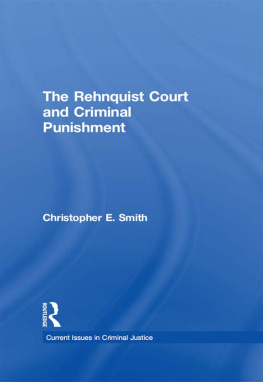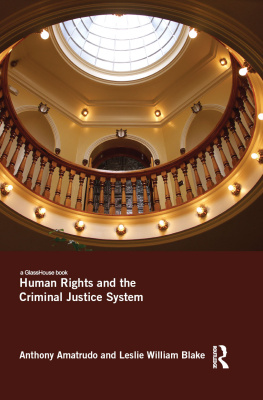
The Pixelated Prisoner
Technological linkages between justice and law enforcement agencies are radically altering criminal process and access to justice for prisoners. Video links, integral to an increasingly networked justice matrix, enable the custodial appearance of prisoners in remote courts and are becoming the dominant form of court appearance for incarcerated defendants. This book argues that the incorporation of such technologies into prisons is not without consequence: technologies make a critical difference to prisoners experiences of criminal justice.
By focusing on the prison endpoint and engaging with the population most affected by video links the prisoners themselves this book interrogates the legal and conceptual shifts brought about by the technologys displacement of physical court appearance. The central argument is that custodial appearance has created a heightened zone of demarcation between prisoners and courtroom participants. This demarcation is explored through transformed spatial, corporeal and visual relationships. Cumulative demarcations challenge procedural justice and profoundly recompose prisoners legal experiences in ways not necessarily recognised by policy-makers.
Carolyn McKay is a Lecturer in Law at the University of Sydney Law School.
Routledge Frontiers of Criminal Justice
The Enforcement of Offender Supervision in Europe
Understanding Breach Processes
Edited by MirandaM. Boone and NiamhMaguire
Diversion in Youth Justice
What Can We Learn from Historical and Contemporary Practices?
Roger Smith
Police-Citizen Relations Across the World
Comparing sources and contexts of trust and legitimacy
Edited by DietrichOberwittler and SebastianRoch
Privatising Punishment in Europe?
Edited by TomDaems and TomVanderBeken
Critical Perspectives on Coercive Interventions
Law, Medicine and Society
Edited by ClaireSpivakovsky, KateSeear and AdrianCarter
The Anthropology of Police
Edited by KevinG. Karpiak and WilliamGarriott
Criminal Justice and Regulation Revisited
Essays in Honour of Peter Grabosky
Edited by LennonY.C. Chang and RussellBrewer
The Pixelated Prisoner
Prison Video Links, Court Appearance and the Justice Matrix
Carolyn McKay
For more information about this series, please visit: www.routledge.com/Routledge-Frontiers-of-Criminal-Justice/book-series/RFCJ
The Pixelated Prisoner
Prison Video Links, Court Appearance and the Justice Matrix
Carolyn McKay
First published 2018
by Routledge
2 Park Square, Milton Park, Abingdon, Oxon OX14 4RN
and by Routledge
711 Third Avenue, New York, NY 10017
Routledge is an imprint of the Taylor & Francis Group, an informa business
2018 Carolyn McKay
The right of Carolyn McKay to be identified as author of this work has been asserted by her in accordance with sections 77 and 78 of the Copyright, Designs and Patents Act 1988.
All rights reserved. No part of this book may be reprinted or reproduced or utilised in any form or by any electronic, mechanical, or other means, now known or hereafter invented, including photocopying and recording, or in any information storage or retrieval system, without permission in writing from the publishers.
Trademark notice: Product or corporate names may be trademarks or registered trademarks, and are used only for identification and explanation without intent to infringe.
British Library Cataloguing-in-Publication Data
A catalogue record for this book is available from the British Library
Library of Congress Cataloging-Publication Data
A catalog record has been requested for this book
ISBN: 978-1-138-08510-7 (hbk)
ISBN: 978-1-315-11150-6 (ebk)
Typeset in Bembo
by Wearset Ltd, Boldon, Tyne and Wear

Figure 0.1 Technosomatica 2012.
Source: Carolyn McKay.
Contents
Figures
0.1 Technosomatica 2012
Tables
Acknowledgements
Undertaking empirical research is never a solo pursuit so there are a number of people and institutions whose support has been invaluable during my PhD study and in transforming my thesis into The Pixelated Prisoner. First and foremost, I wish to thank my PhD supervisory team of Professor Gail Mason and Professor Murray Lee for their criminal law/criminological expertise over the years. Furthermore, the University of Sydney Law School and the Sydney Institute of Criminology have been extremely supportive of my research. I am very grateful to the University and generous scholarship benefactors for awarding me the John OBrien Memorial Research Scholarship in Criminal Law and Criminology; the Cooke, Cooke, Coghlan, Godfrey and Littlejohn Postgraduate Research Scholarship, and Postgraduate Research Support Scheme during my PhD candidature. Later, as a staff member at the University of Sydney Law School, I was awarded a research grant that enabled me to hire a research assistant, Stephanie Classmann who contributed updated and international content.
This project would not have been possible without the support of Corrective Services New South Wales, their staff in head office and the prison officers in the correctional facilities that I visited. I wish to acknowledge the assistance of David McConnell, Peter Sharp and Helen Tsoukalas. Peter was especially helpful in facilitating my access to the video studios and in recruiting prisoners at the correction centres. Of course, I wish to express gratitude to the 31 prisoners who agreed to speak with me and thereby provided extraordinary data. Without their words, this would have been a purely theoretical exercise. In particular, I wish to acknowledge prisoner M04s comment that inspired the books title The Pixelated Prisoner:
Youre only a bunch of pixels on a screen.
Throughout this research, Ive presented at many conferences and published journal articles and book chapters. I thank the editors, anonymous reviewers and conference participants for their thoughtful comments and insights that have enriched my analysis. In addition, my three PhD examiners were extremely generous in their feedback and suggestions for recasting the thesis as a research monograph.
Final thanks to Diana, Al and Barbara for all their support and interest in my pursuits, and to Alexi, Nick and Brian for participating in the production of my related digital artworks.
The Pixelated Prisoner
Prologue
The Parramatta Justice Precinct in western Sydney is a state-of-the-art, technologically integrated and high security complex, home to the New South Wales State Parole Authority. Early in my research, I visited the courthouse to observe a morning of videoconferenced parole hearings. As I walked into Court 7, I was startled by the number of screens installed throughout the contemporary courtroom. I had never seen anything like it before the courtroom felt more like a television studio or video art installation rather than a place of adjudication. I counted over 20 screens and each had the same image of a middle-aged man, staring straight ahead and dressed in a green T-shirt, standard issue of Corrective Services New South Wales. Hanging behind the man was a blue sheet with a paper notice attached at a careless angle. It read Mid North Coast C.C..







